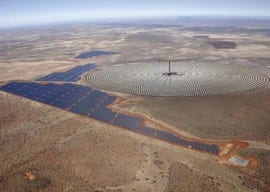The Renewable Energy Independent Power Producers Programme has started delivering financial benefits to the South African power sector and the economy on the whole, a recent study has shown.
 A study by the Council for Scientific and Industrial Research (CSIR) states that the 1.6 GW of wind and solar power capacity commissioned by the end of 2014 helped save more than $450 million. With the payments to these renewable energy projects through feed-in tariffs at around $390 million the net ‘profit’ to the economy from these project is over $60 million.
A study by the Council for Scientific and Industrial Research (CSIR) states that the 1.6 GW of wind and solar power capacity commissioned by the end of 2014 helped save more than $450 million. With the payments to these renewable energy projects through feed-in tariffs at around $390 million the net ‘profit’ to the economy from these project is over $60 million.
Electricity generated from 0.6 GW wind energy projects and 1 GW solar power projects replaced 1.07 TWh electricity from diesel-fired power plants and 1.12 TWh electricity from coal-fired power plants. Renewable energy projects have thus offset more than 2 million tonnes of CO2e emissions in 2014.
Under the Renewable Energy Independent Power Producers Programme (REIPPP) South Africa plans to source 10 TWh electricity from renewable energy projects based on a wide variety of technologies. Generation of this quantum of electricity would be generated from 3,725 MW capacity. The government plans to auction this capacity through competitive bidding.
1.85 GW of onshore wind energy capacity, and 1.45 GW of solar photovoltaic (PV) power capacity will be auctioned by the end of the programme. Other renewable energy technologies include concentrated solar thermal, biomass, biogas, small hydro, and landfill gas.
The net financial saving of over $60 million is an excellent advertisement for the South African renewable energy sector which may see a further boost once the government introduces the carbon tax policy. Companies that would be required to reduce greenhouse gas emissions under the carbon tax policy would be able to fulfil their obligations by generating offsets from renewable energy projects which, as shown by the CSIR, would bring in significant financial savings.
Source: CleanTechnica. Reproduced with permission.







